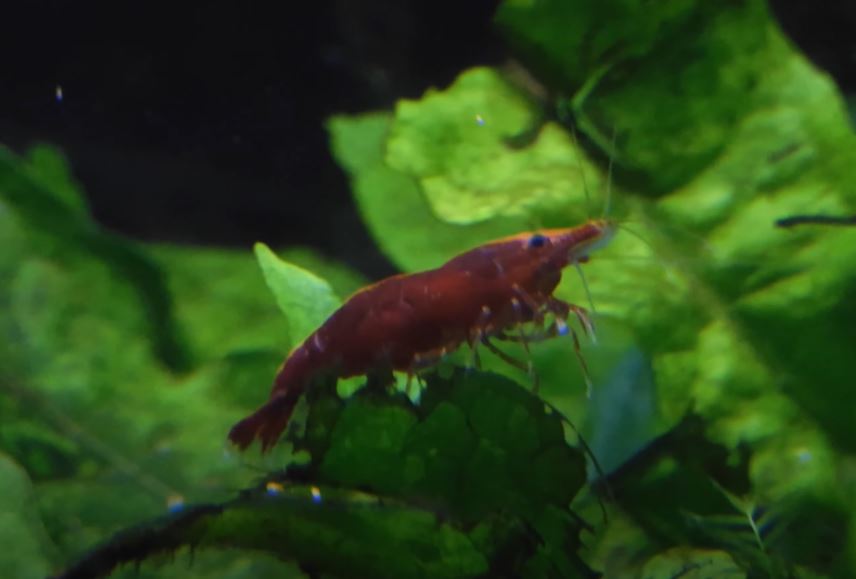If you are wondering why your cherry shrimp is turning black, there are several possible reasons. Here are some of them:
- It could be a natural color change due to genetics. Some cherry shrimp have genes from black ancestors and may develop darker colors as they grow. This is especially common in red cherry shrimp.
- It could be a matter of perception. Some cherry shrimp are naturally black or have black patches, such as the Blue Dream, Green Jade, or Black Rose varieties. The color of the tank background, substrate, and lighting can also affect how you see the shrimp’s color.
- It could be a sign of illness or poor water quality. Some diseases, such as chitinolytic bacterial disease or muscular necrosis, can cause dark spots or lesions on the shrimp’s shell . High ammonia levels, low oxygen levels, or inappropriate pH can also stress the shrimp and make them lose their color .
- It could be a result of death. Sometimes, dead shrimp turn black due to decomposition or bacterial infection.
To determine the cause of your cherry shrimp’s color change, you should observe its behavior and check the water parameters. If the shrimp is active, eating well, and molting normally, it is probably healthy and the color change is natural or harmless. If the shrimp is lethargic, hiding, or not eating, it may be sick or stressed and need treatment.

What is the black discoloration in shrimp?
The black discoloration in shrimp is a condition known as melanosis or blackspot. It is caused by an enzyme process that oxidizes the shrimp’s shell and membranes after exposure to air, similar to how apples turn brown.
It is not harmful or a sign of spoilage, but it may indicate that the shrimp is older. The black discoloration can be prevented by treating the shrimp with a sulfite solution or keeping them chilled.
Why is my cherry shirmp not red?
There are many possible reasons why your cherry shrimp is not red. Some of them are:
- Genetics: Some cherry shrimp have more or less red pigment than others. The color can also vary depending on the age, sex, and breeding history of the shrimp.
- Diet: The food you give your shrimp can affect their color. Some foods can enhance the red pigment, while others can make it fade. Try to feed your shrimp a varied and balanced diet that includes algae, vegetables, and high-quality pellets or flakes.
- Water quality: Poor water quality can stress your shrimp and make them lose their color. Make sure you maintain a clean and stable environment for your shrimp, with optimal parameters for pH, temperature, hardness, and ammonia.
- Lighting: The intensity and spectrum of the light in your aquarium can also influence the color of your shrimp. Brighter and warmer lights can make the red pigment more visible, while dimmer and cooler lights can make it less noticeable.
- Tank mates: If your shrimp feel threatened by predators or aggressive tank mates, they may hide their color to avoid being noticed. Make sure you choose compatible and peaceful fish or invertebrates to share the tank with your shrimp.
Why does my cherry shrimp have a black spot?
A cherry shrimp may have a black spot for different reasons. One possible reason is that it is a female shrimp developing eggs, which is called a saddle.
Another possible reason is that it has a genetic anomaly or it is aging, which can cause its color to change over time.
A third possible reason is that it is sick or stressed, which can lead to shell degradation or bacterial infections .
To determine the cause of the black spot, you should observe the shrimp’s behavior and check the water parameters in your tank.
How to tell the difference between a shrimp molt and dead shrimp?
A shrimp molt is when a shrimp sheds its old exoskeleton and grows a new one. A dead shrimp is when a shrimp stops living and decomposes.
A shrimp molt looks like an empty shell that is clear and intact, while a dead shrimp looks like a pale body that turns pinkish and may be missing parts.
You can also check the eyes of the shrimp: if they are white and cloudy, it is molting; if they are black and shiny, it is dead or alive.
What does a shrimp look like when it’s about to molt?
A shrimp looks different when it’s about to molt. It may become less active and stop eating. It may also change its color to a milky white or gray, especially on its shell and eyes.
These signs indicate that the shrimp is ready to shed its old exoskeleton and grow a new one. Molting is important for the shrimp’s growth and reproduction.
